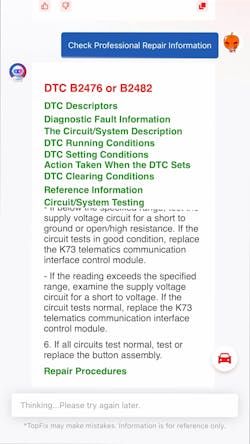It’s impossible to scroll through your social feed, watch the news, or browse the internet without artificial intelligence (AI) creeping into the conversation. And for the most part, the headlines about AI seem grim. Some recent “for instances” include:
- FOX Business: Layoffs in October hit highest level for month in 22 years as companies cite cost-cutting, AI
- CNBC: AI-washing and the massive layoffs hitting the economy
- Variety: Rise of the AI job-killing machines
- The New York Times: IBM to cut thousands of workers amid AI boom
Reading enough headlines might give you an uneasy feeling that something eerily close to the Terminator film franchise is afoot. Are we stuck in a time loop? Is Arnold going to visit us from the future to save us from ultra-smart machines set to systematically wipe out humanity?
Of course (fingers crossed) not.
But let’s not discount the fact that AI is having a very real impact on the business workforce right now. Writing, computer programming, accounting, research, and even acting seem to be the frontline casualties of the AI surge.
But what about auto repair? Are AI robots going to start wrenching on cars?
Probably not.
Thoughts on AI in the auto industry
Some people at the top of the automotive food chain tend to agree that auto repair is, and will remain, in high demand. Ford’s CEO, Jim Farley, has been very vocal lately about the dwindling number of skilled craftsmen in the workforce. For all the talk about how AI will wipe out white collar jobs, he believes too little attention is being paid to skilled crafts like HVAC, plumbing, construction, and, of course, auto repair.
In a LinkedIn post on June 20251, Farley highlighted the fact that the US needs 600,000 more manufacturing workers, 500,000 construction workers, and 400,000 automotive technicians.
“Right now, the problems we’re trying to solve are pretty practical. I need 6,000 technicians in my dealerships on Monday morning,” he says.
Another respected voice in the automotive industry agrees.
Regarding AI’s impact on automotive repair, Haakan Light, the manager of training and development at TOPDON U.S. says, “The future of AI in auto repair isn’t one of human replacement, but rather one of collaboration. It’s simply like every other diagnostic tool in the toolbox. You must combine human intuition and ‘gut feelings’ with AI’s complex computation power in order to understand its limitations and maximize its capabilities.”
Light, who traverses the country training auto technicians, believes AI is a mixed bag of opportunity.
“I already see the front office embracing AI more so than the shop itself. Answering phones, helping with accounting, and setting appointments offer limited risk and have the potential to streamline front office operations,” he notes. “But when we get into the technical operations of the repair shop, there’s some danger in relying wholly on AI technology.”
AI mistakes in auto repair
One of the “for instances” Light offers up is when he used a premium subscription, which taps into more advanced AI models. He wanted to see if it could correctly diagnose and provide a workable solution for a mechanical issue on a vehicle he was repairing.
“I fed the AI model a bunch of information about the problem I was experiencing,” he says. “As a professional with a wide amount of experience and training and deep subject-matter knowledge, I looked at what AI spit out and knew the solution couldn’t be accurate.”
In fact, Light sent AI back to the drawing board by telling it, “Your analysis is backwards. Lambda values above 1.0 are lean. Lambda values below 1.0 are rich. Please recalculate your analysis.”
AI responded with, “You’re absolutely right – my bad. Reworking the snapshot with that in mind.”
The fact that AI responded back with “my bad” is, in and of itself, quite hilarious (Figure 1). But, as humorous as the response may be, AI still made a fundamentally inaccurate assertion and analysis based on the initial inputs. But it was Light’s experience that course-corrected the solution. By leaning on his experience and working through the specific issue with AI, the fault turned out to be a drivability-related issue for fault code P0131: “02 sensor circuit, bank 1, sensor 1, - low voltage.”
In a separate case, a customer approached Light’s colleague, a professional auto diagnostic technician, with all the reasons why his engine light was on – based on a ChatGPT query, of course. While the issues identified by ChatGPT were plausible causes for the engine light being on, only additional tests could prove which one of the issues it was – or if any of them were even valid.
Which, by the way, they weren’t.
Turns out the problem was a mundane and simple vacuum leak. A solution that didn’t even make his customer’s ChatGPT list.
“No matter what the AI model computes or spits out, testing is still required to prove what the problem is,” Light adds. “Sure, AI can help identify tactical problems and shorten the path from issue to repair based purely on statistical probability. But someone still has to roll up their sleeves and put in the elbow grease.”
That’s because automotive repair isn’t just an intellectual exercise. By nature, it’s very physical. Working on a vehicle is not a repetitive task, like bolting screws on a chassis assembly line. It requires a high level of critical thinking, human intuition, and manual labor. Something that robotic AI labor can’t perform.
The future of AI in the shop
Where Light finds AI to be most useful regarding automotive repair, is in the aggregation and analysis of data. Feeding AI data and asking it to look for patterns is something it can do very well – and exposes a technician to less risk - while augmenting efficiency.
For example, AI helped Light spot a pattern from multiple diagnostic scans on the same vehicle (Figure 2). The synthesized AI report concluded that “the Gateway [19] retains all network fault memory and is likely the root hub of communication failure.” The recommended next steps, which, this time, turned out to be helpful in isolating the problem, included checking network instability, power-supply issue, ground/reference drop, and gateway overload (Figure 3). According to Light, the failure on the vehicle was in fact a defective J533 Gateway Control Unit.
“Let’s say you upload a number of SAE PDFs, you can ask AI a specific question related to those documents that can lead to a more accurate response,” Light says. “You can also ask AI to ‘water it down’ or summarize the documents so you can cut through the clutter and get to the more conclusive and critical parts of the documents.”
Light also suggests that AI can be used as a more advanced search engine. Since some AI models are connected to specific automotive resources, like technical service bulletins, AI may be better able to help find that information faster than a traditional browser search.
AI is just another tool
Light’s understanding and experience with AI is helping TOPDON roll out the company’s new TopFix AI scan tool. To explain how this new tool will work, Light gives the example of working on European cars.
"Mechanics who repair European makes usually don’t get enough information from the manufacturer about what a trouble code is, or how it’s being defined," Light says. "TopFix AI can be used to search for extended definitions and additional information on a fault code directly from the OEM.
"For example, if 5,000 technicians are asking the same questions about a specific code, TopFix AI can aggregate the data and provide a higher level of insight into the specific system or component that’s most often associated with the trouble code. It’ll behave similarly to a more sophisticated search engine. The difference is that it will be available through the scan tool itself. That is a game changer.”
TopFix AI, which was introduced at this year’s SEMA Show, will give techs struggling with a repair additional ideas or pathways to start. It can find a bulletin, for example, that’s tied to the specific fault code in question (Figure 4). While it’s not designed to replace a technician’s ability to solve problems, it can give immediate information or feedback that can streamline repairs instead of spending time on exhaustive searches online about the problem.
But what separates TopFix AI in the marketplace is the fact that it’s been developed by automotive professionals, not software engineers. So, it’s specifically designed to help auto technicians who struggle with common repairs, not just perform random, pre-programmed functions.
Light’s hope for AI in the automotive repair space is that it will become a productivity or efficiency tool. “As a trainer, we want to teach everybody how to use their tools effectively, he notes. “Whether we’re talking about a battery tester or charger or scan tool, AI should be seen as just another tool in the toolbox.”
You won’t be replaced by AI
Automotive repair is unpredictable, at best. While vehicles over the years share common engineering, transmissions, fuel, braking, exhaust, and suspension systems, they can be wildly different between vehicle makes and models. There are literally hundreds of thousands of complex components and parts to each vehicle. The idea of asking AI to accurately diagnose and properly identify the solution to an engine light warning is highly unpredictable.
Where Light sees AI as most likely to help the automotive tech is in creating greater efficiency.
“If you can ask AI to retrieve the vehicle manufacturer wiring diagram for a manifold air pressure sensor and have it downloaded directly to your phone,” he explains,” that can have 10 times the value to augment productivity and day-to-day workflow.”
It would be great if AI could tackle diagnostic repairs more efficiently. But maintenance and repair are still going to fill the bays more than specialized diagnostics services. If we can simply ask AI to log into a subscription account to parse service information and retrieve an accurate wiring diagram, Light believes it would be a massive time saver.
While AI can touch many aspects of automotive repair, the nuanced and hands-on nature of the job, not to mention the complex problems presented by vehicles with little to no computerized systems, will remain an essential part of the auto repair process.
“As I see it now, AI is not going to replace the person who is technically trained and who practices every day using their tools,” Light adds. “As I cross the country training technicians, one of the primary concepts I teach is critical thinking. That’s because modern vehicles are highly complex systems of mechanical parts, sensors, electronic components, and software. Nothing can replace that human intuition that comes from observing the sound of an engine knock or the burning smell of a slipping belt.”
So, what’s the takeaway? If you’re an auto technician, or plan to become one, rest assured that it’ll be years…if ever…before AI robots can replace you under the hood or beneath a lifted car.
Now, whether Arnold’s going to jump through a time loop and take your job decades down the road? Well, we’ll just leave that storytelling to Hollywood.




